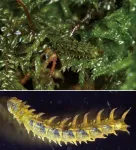Cryptic fleshy coat aids larvae in crawling on a moss carpet
"Fleshy lobes" in insect larvae are known as a tool for camouflage but it was found that they can also serve as a locomotion aid.
2021-02-25
(Press-News.org) Different physical structures play an important role in animal camouflage; however, they are rarely studied compared to the camouflage colors and patterns. All known larvae of long-bodied crane flies (Cylindrotominae) are plant-feeders, feeding either on mosses or herbaceous plants. The terrestrial moss-feeding larvae resemble mosses to a remarkable degree (Fig. 1). The larvae not only have cryptic coloration and patterning, but also are cloaked with special armature; cryptic, fleshy lobes surround their body on dorsal, lateral, and ventral sides. These complex traits serve to trick potential predators by obfuscating typical caterpillar-like outlines.
The question is how a device for camouflage (fleshy lobes) can evolve simultaneously alongside physiological, mechanical, and behavioral functions? After a ten-year pursuit of the larvae, Dr. Imada discovered eight cylindrotomine species in Japan and North America. She explored the link between their ecological background (i.e. habitats and food-plants) and various larval forms. Furthermore, she challenged the conventional explanation of the function of the fleshy lobes, revealing their roles in respiration, attachment, and locomotion.
Major findings of this study are:
Larval morphological and behavioral (defensive behavior and locomotion) features are correlated with the species' habitats, varying from fully terrestrial, submerged, to fully aquatic environments, and their food plants. Notably, the fleshy lobes were longest in aquatic species and are more complex, often with auxiliary outgrowths, in terrestrial moss-feeding species (Fig. 2).
The fleshy lobes in aquatic species, which are among the longest, were previously hypothesized to be gills, by which the larvae absorb dissolved oxygen in water. However, this study did not support this view because they can take in oxygen through the spiracles, the same as terrestrial species, and examination of the ultrastructure of the lobe surface did not reveal evidence for respiration through the cuticles.
Serial cross-sections of the body revealed that the lobes on the lateral sides contained muscles, whereas the dorsal and ventral lobes were simply thickened cuticles (Fig. 3). The musculatures were comparable to those in the prolegs of caterpillars. The result thus cast a new light on the lobes' function as a mechanism for locomotion. The lateral lobes can assist the larvae in crawling.
Dr. Imada concluded that the cylindrotomine larvae live exposed on plants are more prone to predation than most crane flies living in organic mud. Also, the lobes may be adaptive for crawling slowly amongst wet, slippery moss carpets.
Two questions remain unanswered. First, soft, turgid appendages in larvae are curious structures which have evolved in many insect groups, and yet their structures and functions are largely unexplored. Second, the evolution of camouflage in Cylindrotominae remains paradoxical because there seem to be no records of keen-sighted predators, but it is yet to be shown that ground moss patches are enemy-free spaces.
INFORMATION:
Faculty of Science, Ehime University
http://www.sci.ehime-u.ac.jp/en/
[Attachments] See images for this press release:

ELSE PRESS RELEASES FROM THIS DATE:
2021-02-25
As COVID-19 sweeps the world, related viruses quietly circulate among wild animals. A new study shows how SARS-CoV-2, the virus that causes COVID-19, and SARS-CoV-1, which caused the 2003 SARS outbreak, are related to each other. The work, published recently in the journal Virus Evolution, helps scientists better understand the evolution of these viruses, how they acquired the ability to infect humans and which other viruses may be poised for human spillover.
"How did these viruses come to be what they are today? Why do some of them have the ability to infect humans while others do not?" said Simon Anthony, associate professor ...
2021-02-25
WASHINGTON--Hospitalized patients with COVID-19 and abnormal sodium levels in the blood have an increased risk of experiencing respiratory failure or dying, according to a study published in the Endocrine Society's Journal of Clinical Endocrinology & Metabolism.
"This study shows for the first time that patients presenting at the hospital with COVID-19 and low sodium are twice as likely to need intubation or other means of advanced breathing support as those with normal sodium," said lead investigator Ploutarchos Tzoulis, M.D., Ph.D., M.Sc., Honorary Associate Professor in Endocrinology at University College London (UCL) Medical School in London, U.K.
Additionally, the researchers found ...
2021-02-25
An improved high-tech fluorescence microscopy technique is allowing researchers to film cells inside the breast as never seen before.
This new protocol provides detailed instructions on how to capture hi-res movies of cell movement, division and cooperation, in hard-to-reach regions of breast tissue.
The technology - called multiphoton microscopy - uses infrared lasers to illuminate fluorescently labelled breast cells without harming them, so that elusive cell behaviours can be observed within living tissue.
With the new method, WEHI researchers have revealed how breast cells rearrange, interact and sense their environment as the breast grows during development and recedes after lactation.
Cell imaging within living tissue has been ...
2021-02-25
As the frequency and size of wildfires continues to increase worldwide, new research from Carnegie Mellon University scientists shows how the chemical aging of the particles emitted by these fires can lead to more extensive cloud formation and intense storm development in the atmosphere. The research was published online today in the journal Science Advances.
"The introduction of large amounts of ice-nucleating particles from these fires can cause substantial impacts on the microphysics of clouds, whether supercooled cloud droplets freeze or remain liquid, and the propensity of the clouds to precipitate," said Ryan Sullivan, associate ...
2021-02-25
Caught between climate change and multi-year droughts, California communities are tapping groundwater and siphoning surface water at unsustainable rates.
As this year's below-average rainfall accentuates the problem, a public-private partnership in the Monterey/Salinas region has created a novel water recycling program that could serve as a model for parched communities everywhere.
As Stanford civil engineers report in the journal Water, this now urbanized region, still known for farming and fishing, has used water from four sources -- urban stormwater runoff, irrigation drainage, food processing water and traditional municipal wastewater ...
2021-02-25
UNIVERSITY PARK, Pa. -- When healthcare workers become ill during a disease outbreak, overall case counts and mortality rates may significantly increase, according to a new model created by researchers at Penn State. The findings may help to improve interventions that aim to mitigate the effects of outbreaks such as COVID-19.
"Each year dozens of potentially lethal outbreaks affect populations around the world. For example, Ebola ravaged western Africa in 2014; Zika damaged lives in the Americas in 2015; and now we are in the midst of a worldwide pandemic -- COVID-19," said Katriona Shea, professor of biology and Alumni Professor in the Biological Sciences, Penn State. "Healthcare ...
2021-02-25
New York, NY (February 25, 2021) -- Early detection could reduce the number of African Americans dying from liver cancer, but current screening guidelines may not find cancer soon enough in this community, according to a study published in Cancer in February.
Black patients with liver cancer often have a worse prognosis than those of other racial and ethnic groups. Mount Sinai researchers sought to understand the reasons for this disparity by studying patients with hepatitis C, the leading driver of liver cancer in the United States.
Hepatitis C virus infection can result in cirrhosis, ...
2021-02-25
Feb. 25, 2021 - A new paper published online in the Annals of the American Thoracic Society provides a roadmap that critical care clinicians' professional societies can use to address burnout. While strongly needed prior to the COVID-19 pandemic, the roadmap has taken on even greater urgency due to reports of increasing pandemic-related burnout.
In "Professional Societies' Role in Addressing Member Burnout and Promoting Well-Being," Seppo T. Rinne, MD, PhD, of The Pulmonary Center, Boston University School of Medicine, and co-authors from a task force created by the Critical Care Societies Collaborative (CCSC) describe a rigorous process they used to document 17 major professional ...
2021-02-25
The Clalit Research Institute, in collaboration with researchers from Harvard University, analyzed one of the world's largest integrated health record databases to examine the effectiveness of the Pfizer vaccine against COVID-19. The study provides the first large-scale peer-reviewed evaluation of the effectiveness of a COVID-19 vaccine in a nationwide mass-vaccination setting. The study was conducted in Israel, which currently leads the world in COVID-19 vaccination rates.
The results of this study validate and complement the previously reported findings of the Pfizer/BioNTech ...
2021-02-25
Boston, MA - A new approach to pooled COVID-19 testing can be a highly effective tool for curbing the SARS-CoV-2 pandemic, even if infections are widespread in a community, according to researchers at Harvard T.H. Chan School of Public Health and the Broad Institute of MIT and Harvard. Simple pooled testing schemes could be implemented with minimal changes to current testing infrastructures in clinical and public health laboratories.
"Our research adds another tool to the testing and public health toolbox," said Michael Mina, assistant professor of epidemiology at Harvard Chan School and associate member of the Broad. "For public health agencies and clinical laboratories ...
LAST 30 PRESS RELEASES:
[Press-News.org] Cryptic fleshy coat aids larvae in crawling on a moss carpet
"Fleshy lobes" in insect larvae are known as a tool for camouflage but it was found that they can also serve as a locomotion aid.

